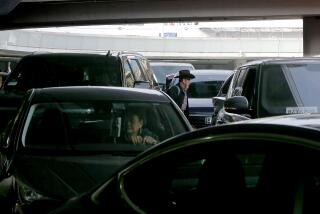Emergency response to LAX shooting addressed at state hearing

After the chaotic evacuation of passenger terminals in last year’s deadly shooting at Los Angeles International Airport, officials said they are making significant improvements to emergency response plans.
The measures include a special team of 300 airport officials to assist stranded passengers and a new wireless communication system that would send information to cellphones during emergencies.
Among the other improvements are conveniently located distribution points for food and water, an enhanced public address system to better inform passengers and more assistance for people with disabilities.
The improvements are designed to address complaints from travelers who were held for hours in LAX passenger facilities on Nov. 1 after a gunman opened fire in Terminal 3 with an assault-style rifle in a hunt for Transportation Security Administration officials.
One TSA agent was killed, and two more agents and a teacher were wounded, before police shot and captured the suspect.
About 23,000 passengers were in the terminals that day, airport officials said. Many were concerned about a lack of information about the situation, limited access to food and water, emergency exits improperly marked and other difficulties evacuating.
Jacqueline Yaft and John Kinney, two high-ranking emergency management officials for Los Angeles World Airports, outlined the new measures during a hearing at LAX held by Assemblyman Freddie Rodriguez (D-Chino).
Rodriguez, who has written a bill to improve emergency procedures statewide, was in Los Angeles to gather information about the LAX shooting and how local law enforcement agencies handle and train for similar situations.
Los Angeles law enforcement and airport officials who testified at the hearing declined to provide the panel information contained in an official after-action report that will be released in mid-March.
After the hearing, Patrick Gannon, chief of the Los Angeles Airport Police Department, told reporters about several problems with communications inside Terminal 3 during the shooting.
He said there was a glitch in an emergency telephone at the TSA security checkpoint the gunman ran through. A TSA official picked up the phone but fled before he speaking to police dispatchers.
Gannon said the line’s caller identification was not working so the dispatcher did not know where the call was coming from and could not take action. He added that the problem has been repaired.
The chief also said two of 12 panic buttons in Terminal 3 that are used to notify authorities in an emergency were broken. There was no indication, however, that the buttons were used during the shooting, he said.
Other questions have been raised for years about the efficiency of 911 systems at the airport.
Many calls are routed from Los Angeles Police Department dispatchers to the airport police, a separate agency. Emergency calls from cellphones go through the California Highway Patrol, which forwards them. The process can take a little extra time.
Gannon said that during the shooting, airport law enforcement received 911 calls from a variety of sources and the response was not delayed by the current system.
He added he was more concerned about the possible delays caused by a deluge of calls to police dispatchers by news media seeking information about the shooting.
“That was disconcerting to me,” Gannon said. “It ties up the phone lines.”
twitter: @LADeadline16
More to Read
Start your day right
Sign up for Essential California for news, features and recommendations from the L.A. Times and beyond in your inbox six days a week.
You may occasionally receive promotional content from the Los Angeles Times.






